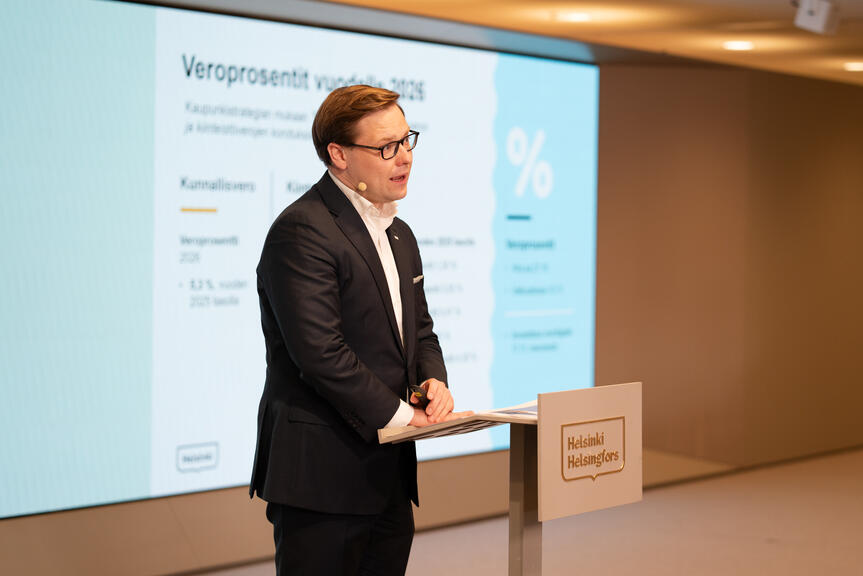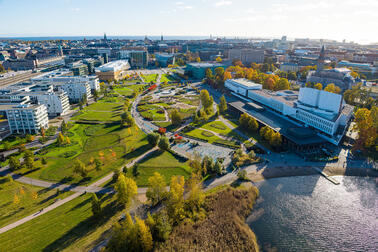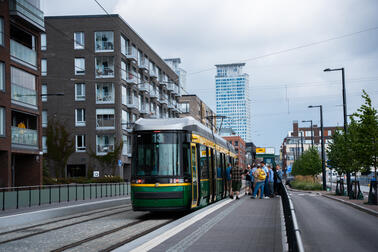
Mayor of Helsinki Daniel Sazonov said the budget for the coming year strongly reflects the priorities outlined in the new Helsinki City Strategy, titled A Helsinki we can be proud of. The mayor said this is especially apparent in the budget’s allocations for services for children and young people, primary schools, healthcare and measures to boost the city’s vitality.
“In terms of the development of the city, it is terrific that we can implement the strategy’s concrete objectives already in the first budget of the council term. This means allocating resources to important issues in the everyday lives of Helsinki residents, such as quality education, swift access to care and the city’s revitalisation,” Sazonov said.
Mayor Sazonov said that although the 2026 budget proposal is being prepared amid a challenging economic situation, there are constant signs of promise on Helsinki's horizon.
“The ailing economy, the prolonged slump in construction and high unemployment levels are all testing Helsinki’s economy. At the same time, positive signs and signals of a turnaround keep becoming visible. The recent icebreaker procurement decision, the growth in tourism in Helsinki and Supercell’s investment in a new head office are all concrete steps towards strengthening Helsinki’s vitality, economy and employment,” Sazonov said.
Helsinki invests and grows
The mayor’s proposal for the total operating expenses for Municipal Helsinki in 2026 is EUR 3.46 billion. This is an approximately 4.6 per cent increase on the 2025 budget. The expenditure increase is driven by high population growth and a rising price index for basic services. The increase in expenditure will be mitigated by a citywide effort to improve annual productivity.
The City of Helsinki’s operating expenses by division are as follows:
- The 2026 operating expenses of the City Executive Office will increase by approximately 5 per cent to EUR 170 million.
- The Education Division’s operating expenses will rise by roughly 3.9 per cent from the 2025 budget to approximately EUR 1.47 billion.
- The Urban Environment Division’s operating expenses will increase to EUR 1.19 billion at the same time that operational income will rise to EUR 1.41 billion. The increase in operating expenses will therefore be 8.7 per cent, while the division’s operational income will see 6.1 per cent growth. The expenditure growth rate is particularly high when it comes to contributions from Helsinki Region Transport (HSL), whose expenses will increase by more than 16 per cent on the previous year.
- The deficit in the operating margin of the 2026 budget for Helsinki’s Culture and Leisure Division will increase by EUR 7.3 million, or 2.9 per cent.
- Operating expenses for the Social Services, Healthcare and Rescue Services Division in the budget proposal are EUR 3.28 billion. The finances of this division are separate from the finances of Municipal Helsinki, as the expenses are covered by state funding and other operating income. The 2026 expenditure for this division is 4 per cent greater than in the 2025 budget.
According to the mayor’s proposal, the City of Helsinki will be making investments of EUR 1.06 billion next year. Some of the largest investments in the coming year will include the construction of a new comprehensive school in the district of Malmi, the construction of a new comprehensive school, daycare centre and sports park in Puistola and the renovation and expansion of a multi-purpose building in Pitäjänmäki.
According to the budget proposal, the annual contribution margin of Municipal Helsinki will improve year-on-year from 2025 but will remain at a substantially lower level than that seen in 2024 and 2023. Because Helsinki has traditionally financed its investment with revenue gains, the decrease in the annual margin will lead to an increase in the city’s debts and liabilities. Due to the negative cash flow from operations and investments, the city will incur debt at an annual rate of approximately EUR 300 million.
Helsinki invests in children, young people and basic services in accordance with strategy
The mayor’s budget proposal made several specific allocations that will promote the implementation of the Helsinki City Strategy’s strategic priorities. In particular, they target the city’s children, youth and basic services and the strengthening of Helsinki’s vitality.
“The budget proposal ensures funding to reduce calculated class sizes in primary education, provide two more hours of comprehensive school studies per week in the language of instruction and increase needs-based funding, in addition to securing the implementation of the learning support reform,” Sazonov said.
“When it comes to social and health services, Helsinki is committed to improving people’s access to these services within the financial framework determined by the state. Next year we will allocate funding for specifically improving access to care. For example, the budget proposal has earmarked roughly EUR 5 million to hire about 50 new doctors,” Sazonov said.
The mayor’s budget proposal also includes several smaller allocations that address the city’s current challenges.
“We will provide more swimming instruction to improve the skills of children and young people. We will increase funding to improve the city’s data security. Next year we are also making a special budget allocation to raise the vitality of the city centre, renew the Innovation Fund so it will encompass a broader spectrum of investments that enable growth and vitality, and invest in the city’s employment services. Supporting Helsinki’s vitality, employment and growth is the best thing we can do to secure the sustainable economy of our city,” Sazonov said.
No tax increases for Helsinki residents, sustainable financial management
Helsinki’s population continues to grow significantly. The number of people in the capital is expected to grow by 9,000 individuals per year in the coming years. Projections say this growth will slow down slightly in the late 2030s to an increase of around 8,000 people per year.
The budget proposal for the coming year has been prepared in line with the financial sustainability principle agreed upon in the Helsinki City Strategy. In practice, this means controlled increases in operating expenditure, moderate investment and the application of the principle of state funding for social, health and rescue services.
Helsinki will not increase its municipal tax and property tax rates in 2026, so they will remain at 2025 levels.
“In the aftermath of the social and health services reform, we have to pay more and more attention to ensuring the sustainability of the city’s finances each year. We have no choice but to respond to Helsinki’s record population increase, but at the same time, we have to curb our growth in expenditures. This will require careful and responsible financial management throughout the entire council term,” Mayor Sazonov said.
“At the same time, we want to be mindful of the purchasing power of Helsinki residents. No increases are being proposed to municipal tax and property tax rates for inhabitants of Helsinki,” Sazonov concluded.
In November, the budget proposal will proceed to the City Board and then to the City Council for consideration. You can follow the progress of the budget process on the City of Helsinki’s website at www.hel.fi/en/decision-making/strategy-economy/budget. The Mayor's 20 October 2025 press conference will be livestreamed on the city’s Helsinki Channel online video service at noon. A recording will made available on the service at a later date, with subtitles in Finnish, Swedish and English.


